
The Artist and The Audience: Writing About the Complexity of Creating Art
From Teju Cole to Anne Carson, Scott O’Connor Recommends Five Books That Go Deep on the Creative Process
A few years ago, I was at an event at a San Francisco art gallery for a novel I’d written about the CIA’s illegal mind control experiments. During the Q&A session, a woman in the audience stood and began to speak. Her desperate intensity created a wary focus in the room. She didn’t have a question; she had something to say, something she wanted us to hear. Ever since she was a child, she said, she’d been the victim of government brainwashing. Covert agencies hounded her, broadcasting coded messages through her TV, bombarding her apartment with radio waves. I can’t sleep, she said, her eyes darting as if she was hunted, or haunted. I haven’t slept in so long. It was impossible to say if she was a victim of some kind of institutional abuse, or mentally ill, or both. Right then it didn’t matter; only her pain mattered. I’m always moving, she said. I’m never safe.
A couple of months later, my son and I visited James Turrell’s Ganzfeld room at the LA County Museum of Art. The room was a blank white space, without corners or seams. Slowly it filled with light, a single color at a time, upending normal perceptions of distance, depth, and gravity. Standing in the room felt like floating, or falling, or being suffused with that light, those colors.
That morning my son and I were alone in the room except for another man, about my age, who stood off by himself. After a while he came over and asked what we thought. I told him it was remarkable, that I wasn’t sure how to describe it. My son, who was about four at the time, said that it felt like he was swimming. Or maybe flying, he said, holding his arms out from his sides.
A year before, the man said, he had suffered a stroke. It affected his speech and mobility, his sense of who he was. He had to leave his job. He stopped dreaming. And it might sound strange, he said, but that was the hardest part, waking up every morning and feeling so empty. He’d come to see the Ganzfeld room when it opened, and that night, he said, he dreamed for the first time in a year. Incredible, vivid dreams. He didn’t know how to describe them either. But he’d been coming back to the room ever since.
The woman in San Francisco lived in a reality of fear and pain, and my book had increased her anguish, even if just for that night. The man at LACMA found hope and beauty in the space James Turrell created. I knew I wanted to write about these complex, complicated relationships with art, the ways in which it can be both healing and harmful.
These experiences were the initial inspiration for what became Zero Zone, a novel about art and trauma and how one sometimes leads to the other. While researching the book, I spoke to artists, and to people about their experiences with art. I watched movies. I visited galleries and museums. And of course, I read: art criticism and history, biographies and memoirs. But increasingly I found myself drawn to another kind of writing, one in which the writer engages so deeply with art that they’re driven to create a book in conversation with that experience. These books were subjective, defiant, joyous, skeptical. Some were fiction, some nonfiction, some an amalgam of the two. All of them spoke to the complexities of creation, and the complicated relationship between artist and audience.
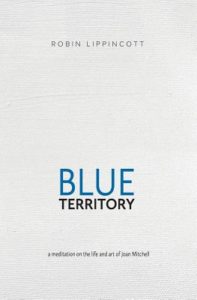
Robin Lippincott, Blue Territory: A Meditation on the Life and Art of Joan Mitchell
(Tidal Press)
Defiant, determined, fully invested in her work, Joan Mitchell was one of the leading lights of 20th century abstract expressionism. Painting in the shadow of the era’s better-known boys’ club of celebrity artists, she reshaped memory and emotion into riots of restless color. Lippincott’s book feels like one of those magic tricks where a small container (only 150 pages!) opens to reveal multitudes: moments from Mitchell’s childhood and adult life, her relationships, her working methods, her joy and despair. This is one artist’s dream of another, a lyrical collage of oral history, biography, and novelistic imagination.
None of Mitchell’s paintings are reproduced in the book. Their absence is, surprisingly, one of Blue Territory’s resounding successes. Lippincott doesn’t simply show us the paintings or try to describe them. (At one point, after an aborted attempt to do just that, he implores us to seek out the work in person or online: “Oh, just [go] look at the goddamn painting!”) Instead, he reimagines the paintings’ absences with scenes from Mitchell’s life—glorious, dangerous moments of creation. It’s a wonderful contradiction, the kind Mitchell embraced throughout her life. Removing the art allows Lippincott to circle it from different angles and depths, revealing truths we might not see looking directly at the paintings. With this book we see around the paintings, behind them, within.
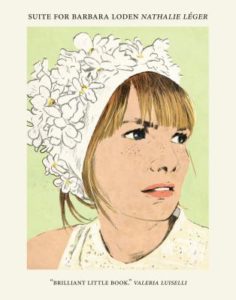
Nathalie Léger, Suite for Barbara Loden
(Dorothy)
For almost 50 years, Barbara Loden’s film Wanda slipped below the critical radar. Or maybe it was shoved there, in an attempt at erasure.
The movie made people uncomfortable. Wanda—who is also played by Loden—is a character who refuses to conform. She leaves her husband and children, her home, the prison of “respectability.” For much of the film she wanders through a world that has nothing to offer her, or which offers nothing she’s willing to accept. Raw and uncompromising, Wanda made no sense to critics and audiences. What the hell was Loden trying to say?
Recently, though, Wanda has reemerged. It’s become a staple in film school syllabuses and revival theaters, and there’s a beautifully restored version from the Criterion Collection. The renewed interest is due in no small part to Nathalie Léger’s Suite for Barbara Loden. Originally hired to write a short entry on the movie for a film encyclopedia, Léger becomes obsessed with Wanda and Loden. She watches the film with her mother, who, like those original critics, professes not to see the point: she resists the movie’s sadness, its rejection of conventional plot. But the film works on her like a sliver under the skin, burrowing deeper until it’s impossible to ignore. Slowly, Léger’s mother reveals her own story: her fear of her ex-husband, Léger’s father; the years of quiet terror and subjugation, the smothering of one personality by another—“the silence,” Léger writes, “that we call consent.” And then the void that opened when Léger’s mother finally separated from him, the absence of that terror that left her with nothing.
Her experiences with Loden’s film cause a reckoning for Léger. She gains a new understanding of her mother. It’s the kind of clear-eyed compassion that comes from finally looking at painful truths, the unvarnished reality that sometimes only art can reveal. It’s like looking at Wanda, Léger writes, “[j]ust as she is, in the world as it is.”
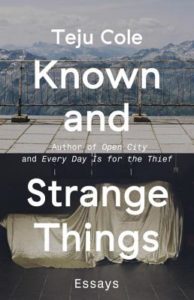
Teju Cole, Known and Strange Things
(Random House Trade)
The title of Cole’s essay collection comes from a line by Seamus Heaney, about how each of us is “a hurry through which known and strange things pass.” For Cole, the things in question are works of art—books, paintings, photographs. But Cole’s essays aren’t judgements or observations. They’re conversations with the work.
One such conversation happens in Leukenbad, Germany, where Cole follows in James Baldwin’s footsteps. In the 1950s, Baldwin stayed in Leukenbad, and found himself the only Black man in the remote resort town. He was stared at, followed by the local children, treated like an exotic curiosity. Sixty years later, Cole also travels to Leukenbad. Things have changed since Baldwin’s time, at least on the surface. The kids listen to Drake and Béyonce. But people stare at Cole, just as they stared at Baldwin. The news from home is about police killings of unarmed Black men. White supremacy still has a stranglehold on much of the world.
Traveling alongside Baldwin’s essay, agreeing with it at times, disagreeing at others, helps Cole process his own experience. The new essay that emerges is a kind of dialogue—one brilliant, observant mind in conversation with another, “thinking,” as Cole writes, “with its help.”
Throughout the book Cole thinks alongside the work of a wide range of artists. Their work acts as guide, challenger, foil, advocate, reminding us that an engagement with art is not a passive experience, but the start of a conversation.
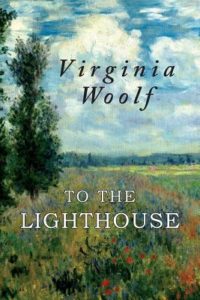
Virginia Woolf, To the Lighthouse
(Albatross Publishers)
Woolf inhabits her characters so deeply that To the Lighthouse often seems like a different book with each return visit. Sometimes it’s Mrs. Ramsay’s story; sometimes it feels centered on Mr. Ramsay. Rereading this time, it felt like the novel belonged to Lily Briscoe, a portrait of an artist.
At the beginning of the book Lily starts a painting, and then a bunch of things happen: she’s disturbed and distracted, criticized, wracked by insecurity, lifted by moments of inspiration. Loved ones have children, go to war, disappear into their own lives. Ten years pass. All the while she wrestles with “untying the knot in her imagination,” trying to get the painting in her head out onto the canvas. She can see it, but only for a few fleeting moments before it vanishes again in the bustle of everyday life.
Woolf was a fierce advocate for an artist’s need for solitude and silence, a clarifying distance from the world’s endless distractions. But those noisy, overcrowded moments also form the core of Woolf’s novels. The distractions are, simply, life. And without them there’s no story to tell, no art to create. This is Lily’s struggle, finding the balance between solitude and engagement.
I don’t think I’ve ever read a more perfect dramatization of the creative process of most writers and artists I know. We start a book or painting or piece of music, then a bunch of things occur: we fall in love, raise children, lose loved ones, work other jobs, walk the dog, do the dishes—life happens, both informing and confounding our artistic efforts. At the end, if we’re lucky, if we persevere, we have that book or painting or piece of music, as bruised and wondrous as all the years that went into it.
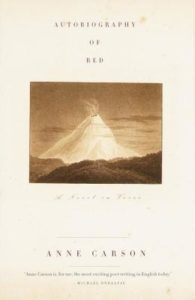
Anne Carson, Autobiography of Red
(Vintage)
On a list of twelve, no one wants to be number ten. You’d rather find yourself first or last, in one of the memorable spots at the beginning or end of the story. In Greek mythology, Herakles had twelve labors. The first was to slay the Nemean lion with his bare hands. Then, at the tail end of his journey, he descended into Hades to capture Cerberus, the ferocious, three-headed dog. Impressive stuff. What was number ten on Herakles’s list? Cattle rustling. He traveled to the island of Erytheia to steal cows from the red, winged monster Geryon. Geryon died for those cows. But who remembers him? Everyone remembers Cerberus. No one wants to be number ten.
Two thousand-plus years later, Anne Carson reimagined the story from Geryon’s point of view in the gorgeously written, wonderfully strange Autobiography of Red. Geryon now resides in a version of our present day, and his autobiography is a coming-of-age story about a boy who could be, in fact, a monster, or might simply feel like one.
Some of the myth’s original fragments are reproduced at the beginning of the book, where they serve as tantalizing clues to a lost history. Carson works from those clues, but she’s equally interested in the gaps between fragments. Autobiography of Red comes alive in those forgotten spaces, reveling in the possibilities of the unknown. The answers are always less interesting than the questions.
__________________________________
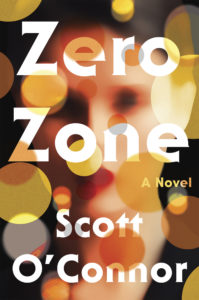
Zero Zone by Scott O’Connor is available now via Counterpoint LLC.
Scott O’Connor
Scott O’Connor is the author of A Perfect Universe: Ten Stories and the novels Half World and Untouchable, which was awarded the 2011 Barnes & Noble Discover Great New Writers Award for Fiction. His stories have been shortlisted for the Sunday Times/EFG Story Prize and cited as Distinguished in Best American Short Stories. Additional work has appeared in The New York Times Magazine, Zyzzyva, The Rattling Wall, and The Los Angeles Review of Books. He teaches creative writing at Cal State Channel Islands.



















